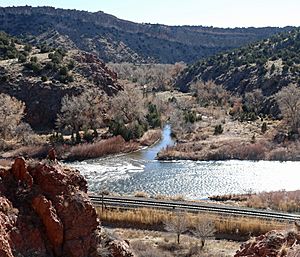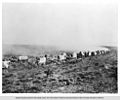Early history of the Arkansas Valley in Colorado facts for kids
The early history of the Arkansas Valley in Colorado is about the time when European hunters, trappers, and traders first arrived. This happened in the 1700s and early 1800s. Before them, Colorado was home to many ancient groups of people. These included the Paleo-Indians, Ancestral Puebloans, and later Native American tribes.
As the United States expanded west, new trading posts and small towns appeared. These were built in the valleys of the Arkansas River and South Platte River. Important places like Bent's Fort and El Pueblo were created. Southern Colorado used to be part of New Spain. It became part of the United States in 1848 after the Mexican–American War (1846-48). Many people started moving to Colorado during the Colorado Gold Rush of 1858. Colorado officially became a state in 1876.
Contents
Early Trading Posts in Arkansas Valley
The Arkansas Valley was an important area for trade. Many people came here to trade furs and goods. These early posts helped shape the region.
John Gantt's Fort
The very first adobe trading post on the upper Arkansas River was built by John Gantt. He was a former Army officer. He built it in May 1834. The fort was on the north side of the Arkansas River. It was about six miles below Fountain Creek.
Soon, another trader named William Bent attacked Gantt's Fort. Bent managed a nearby stockade. He attacked Shoshone people who were trading at Gantt's Fort. He killed some and drove them away. Gantt left his fort that winter. The Bents also left their stockade. They built Bent's Fort about 70 miles down the Arkansas River. Mexican workers built these adobe forts. They were a big part of the workforce. They helped create the mixed culture of Southern Colorado.
Bent, St. Vrain & Company
Bent, St. Vrain & Company was a trading business. It was started in New Mexico by Charles Bent and Ceran St. Vrain. They were traders on the Santa Fe Trail. In 1832, they got licenses to trade with Native American tribes. They finished building Bent's Fort in 1835. Charles' younger brother, William, managed the fort. Later, William and his younger brothers, George and Robert, became partners.
The company also had Fort St. Vrain on the South Platte River. Ceran's younger brother, Marcellin St. Vrain, managed it. They also had a store in Taos. Charles Beaubien managed this store. The company had strong ties with the Cheyenne people. William Bent married Owl Woman. She was the daughter of White Thunder, a Cheyenne leader. The company also tried to trade with the Kiowa and Comanche tribes. They built a post on the South Canadian River. This post was not used for long. Later, two battles were fought at its ruins. These ruins became known as Adobe Walls.
Fort Pueblo
Fort Pueblo was another adobe settlement and trading post. It was built in 1842. A group of independent traders built it. It was located at a crossing of the Arkansas River. This was about half a mile west of the Fountain River. The exact spot is not certain today. It is thought to be near First Street and Santa Fe Avenue in Pueblo, Colorado. Floods have changed the river's path. The old crossing and the fort's buildings are now gone.
George Simpson was one of the builders of Fort Pueblo. He was the son of a rich merchant from St. Louis. In May 1841, when he was 23, he started his journey on the Oregon Trail. He had a wagon pulled by mules. Simpson received money from his father throughout his life. He stopped his journey at Fort Laramie. There, William S. Williams invited him to join fur trappers. Simpson did not go trapping. Instead, he was hired by Robert Fisher, a trader for Bent & St. Vrain. He traveled to Bent's Fort. There, he learned how to trade with Native Americans. Fisher was his main partner in starting Fort Pueblo.
Images for kids
-
Bent's Fort in 1848.
-
A train of covered wagons on the Santa Fe Trail.
-
This image shows what the fort might have looked like. It is called Mexican Ranch by Colonel Henry Inman. It was published in The Old Santa Fe Trail in 1897.






